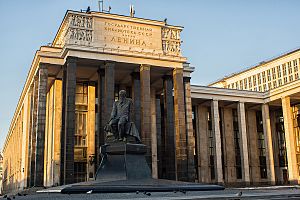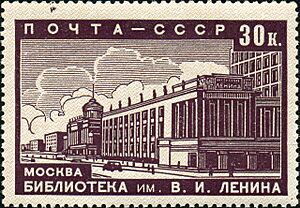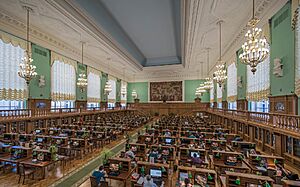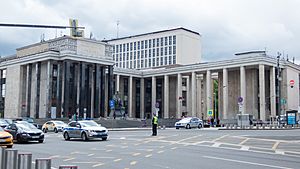Russian State Library facts for kids
Quick facts for kids Russian State Library |
|
|---|---|
 |
|
 |
|
| Main building of the library. The façade still retains the Soviet-era name "Lenin State Library of the USSR" | |
| Country | Russia |
| Type | National library |
| Established | 1862 |
| Location | Moscow |
| Branches | 3 |
| Collection | |
| Items collected | Books, journals, newspapers, magazines, sound and music recordings, patents, databases, maps, stamps, prints, drawings and manuscripts |
| Size | 47.7 million (2020) |
| Criteria for collection | All publications published in Russia, all Russian-language publications published abroad, all foreign-language publications about Russia and other materials |
| Legal deposit | Yes, since 1922 |
| Access and use | |
| Access requirements | Users must be at least 14 years old and present a valid passport or ID card. |
| Circulation | 1.116 million (2019) |
| Members | 387,000 (2019) |
| Other information | |
| Budget | ₽2.4 billion (2019) |
| Director | Vadim Duda |
| Staff | 1,699 (2019) |
The Russian State Library (Russian: Российская государственная biblioteka) is a huge library in Moscow, Russia. It is one of the biggest libraries in the world. It is the largest library in Russia and the second largest in Europe. In 2017, it held over 47 million items. The library is managed by the Ministry of Culture.
The library started in 1862 as the Moscow Public Museum and Rumyantsev Museum. It grew from many collections, especially Count Nikolay Rumyantsev's books. In 1924, it was renamed after Lenin and was often called the Lenin Library. Its current name, the Russian State Library, was given in 1992.
The library has several buildings with different looks. In 2012, its shelves stretched for over 275 kilometers! This included more than 17 million books, 13 million magazines, and many other items. The library has items in 247 languages. In 2017, its collection covered over 360 languages.
Contents
History of the Library
The Rumyantsev Library Begins
The library opened on July 1, 1862. It was Moscow's first free public library. It was part of the Moscow Public Museum and Rumyantsev Museum. People often called it the Rumyantsev library.
The Rumyantsev Museum held the historical collection of Count Nikolai Petrovich Rumyantsev. He gave his collection to the Russian people. It included many books, old writings, coins, and cultural items. About 200 paintings and over 20,000 prints from the Hermitage Museum were also added. These items were displayed in the Pashkov House. This beautiful palace was built between 1784 and 1787, close to the Kremlin.
Tsar Alexander II of Russia gave a famous painting, The Appearance of Christ Before the People, for the museum's opening. Moscow citizens were very impressed by Count Rumyantsev's gift. They named the new museum after him. They even carved "from count Rumyantsev for the good Enlightenment" above its entrance. Over the years, many more people donated items and money. The museum's collection grew so large that the Pashkov House became too small. A second building was built nearby in the early 1900s, especially for the paintings.
The Lenin Library Era
After the October Revolution, the library's collection grew even more. Again, there was not enough space. Also, money became a big problem. Much of the museum's funding went to the Pushkin Museum, which was newer. So, in 1925, it was decided to close the Rumyantsev Museum. Its collections were sent to other museums and places. Some art and old items went to the Pushkin Museum.
The Pashkov House was renamed the Old Building of the Russian State Library. A new building was planned. In 1925, the library was renamed the V. I. Lenin State Library of the USSR. People often called it "Leninka."
A competition was held in 1927 to design the new Lenin Library buildings. The design by Vladimir Shchuko and Vladimir Gelfreikh was chosen. Construction began in 1930. Famous sculptors like Matvey Manizer worked on it. The first part was mostly finished by 1941. The building looked like a modern version of old classical buildings. The last part of the plan, a large reading hall, opened in 1945. More additions continued until 1960.
During this time, the library was seen as a "mass library." It was a main library, a national storage place, and a research center. It also helped create lists of books. The library's rules said it should "contribute to the development of communism in USSR." About 5,000 to 6,000 people visited it every day.
The Lenin Library received three copies of every printed item in the Soviet Union. It could use these for trading books with other libraries. Until 1955, it was one of only two places allowed to trade books internationally. Over 40,000 international books, mostly about science, came into the library this way. By the mid-1950s, the library was trading with 60 countries. It also loaned books to and borrowed from libraries in Russia and other countries.
In 1961, the library had 22 reading rooms. By 1976, up to 8,000 people visited these rooms daily. A special department helped readers find books. The library also advised other libraries on which books to buy. The library staff in 1961 included 1,750 librarians.
The library's books were cleaned twice a year and checked constantly. Books with problems went to a special department for repair. This department fixed about 380,000 pages each year. Microfilm was used to save old documents.
By 1968, the main building was full. So, the library started building a new storage area in Khimki. This new place was for newspapers, scientific works, and less-used books. The first part of the Khimki library was finished in 1975. From 1922 to 1991, at least one copy of every book published in the USSR was sent to the library. This practice continues today, as the library is a legal deposit library. This means publishers must send copies of their works to it.
The Russian State Library Today
In 1992, President Boris Yeltsin renamed the library the Russian State Library. A law passed in 1994 made it an official national library. This means it stores government documents, foreign documents, and serves the armed forces. It also acts as a central point for a system of libraries. The Russian State Library works closely with the National Library of Russia, which has been a national library since 1795. They agreed in 1996 to work together on things like storing legal deposit copies.
The reading rooms at the library are organized by topic. Scholars and important people used these rooms. Today, the Russian State Library helps other libraries across the country. It also works to find and record "trophy" items in its collections. The Pashkov House was renovated and finished in 2007. The Ivanovo Hall is now a main exhibition area. There is also a permanent book museum. The library hosts many events. For example, in May 2019, a famous rap artist gave a talk in the largest reading room.
Library Collections
The library started with the personal collection of Count Nikolai Petrovich Rumyantsev. When he passed away in 1826, it had about 28,000 to 29,000 books. By 1899, the library had grown to half a million books. In the next 20 years, it reached over 1 million books. The collection grew a lot through buying new items and taking over other collections.
In 1951, the Lenin Library had the largest collection of books in the world. It stayed the largest until at least 1973. By 1959, the collections had over 20 million items. In 1961, there were 250,000 rare publications. There were also 30,000 old writings from the 11th to 15th centuries. In 1994, the library's holdings went over 40 million.
In 2000, the library had 42 million items. These included books in both living and dead languages. That year, the library received over 357,000 new documents. The collections include old writings from the sixth century. There are also family records, personal papers of famous people, and a collection of autographs.
The library owns a Gutenberg Bible. It also has Ivan Fedorov's "Apostles" from 1564. You can find first editions of works by Nicolaus Copernicus, Charles Darwin, and Isaac Newton. There are over 250,000 United Nations documents. The library also has maps, military books, music, sound recordings, and newspapers. In 2017, the collection had over 47 million items in 360 languages.
The Electronic Library department started in the mid-1990s. Its first collection had 900,000 theses in Russian. The library also works with the United Nations' Memory of the World Programme. They have digitized old Russian newspapers, maps, and posters. They also worked with the Library of Congress in the United States and the European Union to digitize more items. For music, they digitize old printed music to save it and make it easier to find. The Digital Dissertation Library began in 2003. As it grew, more virtual reading rooms opened, even in other countries.
Research and Publications
The library is a place for research in library science and related fields. The Lenin Library published many things. These included collections, guides, catalogs, and lists of books. It also published works on social and political topics, and art. The journal Bibliotekovedenie (Russian Journal of Library Science) started in 1952. It got its current name in 1993. Another journal, Observatory of Culture, began in 2004. The journal Vostochnaya Kollektsiya (Oriental Collection) was published from 1999 to 2015. It had 61 issues with over 1,200 articles. Pashkov Dom Publishing was set up in 1998 to publish books for the library.
Gallery
-
Russian State Library stamp (Soviet times)
-
The wedding of tsar Michael I
See also
 In Spanish: Biblioteca del Estado Ruso para niños
In Spanish: Biblioteca del Estado Ruso para niños
- Russian Book Chamber
- National Library of Russia
- Boris Yeltsin Presidential Library











